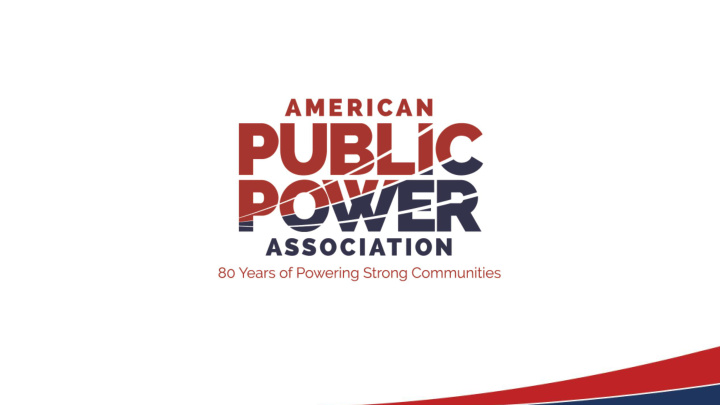



APPA Update: Public Power Forward JOY DITTO President & CEO American Public Power Association USEA 16 th Annual State of the Energy Industry Forum January 23, 2020 #PublicPower www.PublicPower.org
What Are Public Power Utilities? • Public power defined : “A utility owned by a political subdivision of a State, such as a municipally-owned electric utility; and, a utility owned by any agency, authority, corporation, or instrumentality of one or more political subdivisions of as state” • Not-for-profit , public, community-oriented, responsive • Rates are governed locally • Subject to federal environmental, endangered species, reliability/critical infrastructure protection regulation – limited federal regulation for public power transmission owners (known as FERC-lite) • Mostly transmission-dependent (pay for third-party access to transmission) • Purchase more power than produced , but generating capacity is: 42% natural gas; 26.6% coal; 18% hydropower; 6.5% nuclear; 4.8% oil; 1.5% other, and .7% wind #PublicPower www.PublicPower.org
Who Are APPA’s Members? • 1,400+ public power utilities (of 2,000 total in the U.S.) • Retail service in 49 states (all but Hawaii) • Very large to very small utilities • Median size: 1,977 meters • 14.4% of sales to electric consumers #PublicPower www.PublicPower.org
What Do We Care About in Federal Policy for 2020? • Climate change policy best left to Congress; diversity of fuels important – from 2005-2017, public power utilities have reduced their CO2 emissions by 33% from 2005 levels • Comparable incentives to those made available to for-profit entities for clean energy development • Municipal bonds – primary funding source for projects, bills pending to make more workable • Grid security and grid security funding – support H.R. 359/S. 2095 to permanently fund at DOE activities to enhance grid security #PublicPower www.PublicPower.org
What Do We Care About in Federal Policy for 2020? (Cont.) • Power Marketing Administrations and the Tennessee Valley Authority – defend core mission and cost-based rates • Pole attachments – public power exemption to FCC regulation must be maintained • Spectrum policy – utilities’ reliable use of spectrum for critical networks and grid of the future deployments must be preserved • Electric vehicles – support funding for charging infrastructure • Transmission – FERC should adopt and enforce policies to keep rates reasonable • Wholesale markets – oppose FERC’s December order to expand PJM’s minimum offer price rule • Distributed energy resources and storage – support these technologies, but should not participate in wholesale markets without state and local regulator consent #PublicPower www.PublicPower.org
Federal Policy Should Enable Public Power to Move Forward • Policies should incentivize public power utilities to move into a future of greater communication and relationship with our customers -- or at least do no harm . Currently, this is a mixed bag • Positive example : Great progress in the relationship between the electric sector and the federal government around resilience and preparedness -- cyber and physical. APPA using federal grants from DOE to h elp members develop “all - hazards” approach to disaster preparation and response. • Detrimental example : wholesale market structures and preemptions of state and local decision-making – particularly in FERC’s expansion of the PJM MOPR. #PublicPower www.PublicPower.org
Good to Be Home! Questions? Joy Ditto jditto@publicpower.org 202-467-2901 #PublicPower www.PublicPower.org
Recommend
More recommend